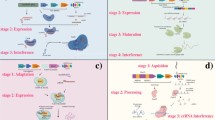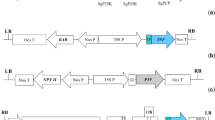Abstract
Virus-induced gene silencing (VIGS) is a method of rapid and transient gene silencing in plants using viral vectors. A VIGS vector for gene silencing in rice has been developed from Rice tungro bacilliform virus (RTBV), a rice-infecting virus containing DNA as the genetic material. A full-length RTBV DNA cloned as a partial dimer in a binary plasmid accumulated in rice plants when inoculated through Agrobacterium (agroinoculation) within 2 weeks and produced detectable levels of RTBV coat protein. Deletion of two of the four viral ORFs did not compromise the ability of the cloned RTBV DNA to accumulate in rice plants. To modify the cloned RTBV DNA as a VIGS vector (pRTBV-MVIGS), the tissue-specific RTBV promoter was replaced by the constitutively expressed maize ubiquitin promoter, sequences comprising the tRNA-binding site were incorporated to ensure reverse transcription-mediated replication, sequences to ensure optimal context for translation initiation of the viral genes were added and a multi-cloning site for the ease of cloning DNA fragments was included. The silencing ability of pRTBV-MVIGS was tested using the rice phytoene desaturase (pds) gene on rice. More than half of the agroinoculated rice plants showed white streaks in leaves within 21 days post-inoculation (dpi), which continued to appear in all emerging leaves till approximately 60–70 dpi. Compared to control samples, real-time PCR showed only 10–40% accumulation of pds transcripts in the leaves showing the streaks. This is the first report of the construction of a VIGS vector for rice which can be introduced by agroinoculation.




Similar content being viewed by others
Abbreviations
- VIGS:
-
Virus-induced gene silencing
- RTBV:
-
Rice tungro bacilliform virus
- PDS:
-
Phytoene desaturase
- RNAi:
-
RNA interference
- GLH:
-
Green leafhopper
References
Borah BK, Johnson AMA, Sai Gopal DVR, Dasgupta I (2008) A comparison of four DNA extraction methods for the detection of citrus yellow mosaic badnavirus from two species of citrus using PCR and dot-blot hybridisation. J Virol Methods 151:321–324
Bouhida M, Lockhart BEL, Olszewski NE (1993) An analysis of the complete sequence of a sugarcane bacilliform virus genome infectious to banana and rice. J Gen Virol 74:15–22
Bruun-Rasmussen M, Madsen CT, Jessing S, Albrechtsen M (2007) Stability of barley stripe mosaic virus-induced gene silencing in barley. Mol Plant Microbe Interact 20:1323–1331
Burch-Smith TM, Schiff M, Liu Y, Dinesh-Kumar SP (2006) Efficient virus-induced gene silencing in Arabidopsis. Plant Physiol 142:21–27
Cai X, Wang C, Xu Y, Xu Q, Zheng Z, Zhou X (2007) Efficient gene silencing induction in tomato by a viral satellite DNA vector. Virus Res 125:169–175
Chellappan P, Vanitharani R, Ogbe F, Fauquet CM (2005) Effect of temperature on geminivirus-induced gene silencing. Plant Physiol 138:1828–1841
Clark MF, Adams AN (1977) Characteristics of the microplate method of enzyme-linked immunosorbent assay for the detection of plant viruses. J Gen Virol 34:475–483
Dai S, Zhang Z, Chen S, Beachy RN (2004) RF2b, a rice bZIP transcription activator, interacts with RF2a and is involved in symptom development of rice tungro disease. Proc Natl Acad Sci USA 101:687–692
Dai S, Zhang Z, Bick J, Beachy RN (2006) Essential role of the Box II cis element and cognate host factors in regulating the promoter of rice tungro bacilliform virus. J Gen Virol 87:715–722
Dai S, Wei X, Alfonso AA, Pei L, Duque UG, Zhang Z, Babb GM, Beachy RN (2008) Transgenic rice plants that over-express transcription factors RF2a and RF2b are tolerant to rice tungro virus replication and disease. Proc Natl Acad Sci USA 105:21012–21016
Dasgupta I, Hull R, Eastop S, Poggi-Pollini C, Blakebrough M, Boulton MI, Davies JW (1991) Rice tungro bacilliform virus DNA independently infects rice after Agrobacterium-mediated transfer. J Gen Virol 72:1215–1221
Dellaporta SL, Wood J, Hicks JB (1983) A plant DNA mini-preparation, version II. Plant Mol Biol Rep 1:19–21
Ding XS, Schneider WL, Chaluvadi SR, Rouf Mian M, Nelson RS (2006) Characterization of a brome mosaic virus strain and its use as a vector for gene silencing in monocotyledonous hosts. Mol Plant Microbe Interact 19:1229–1239
Encabo JR, Cabauatan PQ, Cabunagan RC, Satoh K, Lee JH, Kwak DY, De Leon TB, Macalalad RJ, Kondoh H, Kikuchi S, Choi IR (2009) Suppression of two tungro viruses in rice by separable traits originating from cultivar Utri Merah. Mol Plant Microbe Interact 22:1268–1281
Fauquet CM, Mayo MA, Maniloff J, Desselberger U, Ball LA (2005) Virus taxonomy. Eighth Report of the International Committee for the Taxonomy of Viruses. Academic Press, New York
Fu DQ, Zhu BZ, Zhu HL, Zhang HX, Xie YH, Jiang WB, Zhao XD, Luo KB (2006) Enhancement of virus-induced gene silencing in tomato by low temperature and low humidity. Mol Cells 21:153–160
Grimsley N, Hohn B, Hohn T, Walden R (1986) “Agroinfection” an alternative route for viral infection of plants by using the Ti plasmid. Proc Natl Acad Sci USA 83:3282–3286
Hay JM, Jones MC, Blakebrough ML, Dasgupta I, Davies JW, Hull R (1991) An analysis of an infectious clone of rice tungro bacilliform virus, a plant pararetrovirus. Nucleic Acids Res 19:2615–2621
Hendrix RW, Garcea RL (1994) Capsid assembly of dsDNA viruses. Semin Virol 5:15–26
Herzog E, Guerra-Peraza O, Hohn T (2000) The rice tungro bacilliform virus gene II product interacts with the coat protein domain of the viral gene III polyprotein. J Virol 74:2073–2083
Höfgen R, Willmitzer L (1990) Biochemical and genetic analysis of different patatin isoforms expressed in various organs of potato (Solanum tuberosum). Plant Sci 66:221–230
Holzberg S, Brosio P, Gross C, Pogue GP (2002) Barley stripe mosaic virus-induced gene silencing in a monocot plant. Plant J 30:315–327
Hood EE, Gelvin SB, Melchers LS, Hoekema A (1993) New Agrobacterium helper plasmids for gene transfer to plants. Transgenic Res 2:208–218
Huang Q, Hartung JS (2001) Cloning and sequence analysis of an infectious clone of Citrus yellow mosaic virus that can infect sweet orange via Agrobacterium-mediated inoculation. J Gen Virol 82:2549–2558
Hull R (1996) Molecular biology of rice tungro viruses. Annu Rev Phytopathol 34:275–297
International Rice Genome Sequencing Project (2005) The map-based sequence of the rice genome. Nature 436:793–800
Kozak M (1989) The scanning model for translation: an update. J Cell Biol 108:229–241
Laco GS, Beachy RN (1994) Rice tungro bacilliform virus encodes reverse transcriptase, DNA polymerase, and ribonuclease H activities. Proc Natl Acad Sci USA 91:2654–2658
Laco GS, Kent SB, Beachy RN (1995) Analysis of the proteolytic processing and activation of the rice tungro bacilliform virus reverse transcriptase. Virology 208:207–214
Lacomme C, Hrubikova K, Hein I (2003) Enhancement of virus-induced gene silencing through viral-based production of inverted-repeats. Plant J 34:543–553
Leclerc D, Burri L, Kajava AV, Mougeot JL, Hess D, Lustig A, Kleemann G, Hohn T (1998) The open reading frame III product of cauliflower mosaic virus forms a tetramer through a N-terminal coiled-coil. J Biol Chem 273:29015–29021
Liu Y, Schiff M, Marathe R, Dinesh-Kumar SP (2002) Tobacco Rar1, EDS1 and NPR1/NIM1 like genes are required for N-mediated resistance to tobacco mosaic virus. Plant J 30:415–429
Lu R, Malcuit I, Moffett P, Ruiz MT, Peart J, Wu AJ, Rathjen JP, Bendahmane A, Day L, Baulcombe DC (2003) High throughput virus-induced gene silencing implicates heat shock protein 90 in plant disease resistance. EMBO J 22:5690–5699
Marmey P, Bothner B, Jacquot E, de Kochko A, Ong CA, Yot P, Siuzdak G, Beachy RN, Fauquet CM (1999) Rice tungro bacilliform virus open reading frame 3 encodes a single 37-kDa coat protein. Virology 253:319–326
Mathur S, Dasgupta I (2007) Downstream promoter sequence of an Indian isolate of rice tungro bacilliform virus alters tissue-specific expression in host rice and acts differentially in heterologous system. Plant Mol Biol 65:259–275
McElroy D, Chamberlain DA, Moon E, Wilson KJ (1995) Development of a gusA reporter gene construct for cereal transformation, availability of plant transformation vectors from CAMBIA molecular genetic resource service. Mol Breed 1:27–37
Medberry SL, Lockhart BEL, Olszewski NE (1990) Properties of commelina yellow mottle virus’s complete DNA sequence, genomic discontinuities and transcript suggest that it is a pararetrovirus. Nucleic Acids Res 18:5505–5551
Moissiard G, Voinnet O (2006) RNA silencing of host transcripts by cauliflower mosaic virus requires coordinated action of the four Arabidopsis Dicer-like proteins. Proc Natl Acad Sci USA 103:19593–19598
Nath N, Mathur S, Dasgupta I (2002) Molecular analysis of two complete rice tungro bacilliform virus genomic sequences from India. Arch Virol 147:1173–1187
Nethra P, Nataraja KN, Rama N, Udayakumar M (2006) Standardization of environmental conditions for induction and retention of post-transcriptional gene silencing using tobacco rattle virus vector. Curr Sci 90:431–435
Purkayastha A, Dasgupta I (2009) Virus-induced gene silencing: a versatile tool for discovery of gene functions in plants. Plant Physiol Biochem 47:967–976
Raghuvanshi S (2001) Investigations on chloroplast transformation and characterization of constitutively photomorphogenic 1 (COP1) gene in rice. Ph.D. Thesis, University of Delhi
Roberts CS, Rajagopal S, Smith LA, Nguyen TA, Yang W, Nuroho S, Ravi KS, Cao M-L, Vijayachandra K, Patell V, Harcourt R, Dransfield L, Desamero N, Slamet I, Keese P, Kilian A, Jefferson RA (1998) A comprehensive set of modular vectors for advanced manipulations and efficient transformation of plants by both Agrobacterium and direct DNA uptake methods. pCAMBIA Vector release manual version 3.05. CAMBIA. Canberra, Australia
Scofield SR, Huang L, Brandt AS, Gill BS (2005) Development of a virus-induced gene-silencing system for hexaploid wheat and its use in functional analysis of the Lr21-mediated leaf rust resistance pathway. Plant Physiol 138:2165–2173
Szittya G, Molnar A, Silhavy D, Hornyik C, Burgyan J (2002) Short defective interfering RNAs of tombusviruses are not targeted but trigger post transcriptional gene silencing against their helper virus. Plant Cell 14:359–372
Szittya G, Silhavy D, Molnar A, Havelda Z, Lovas A, Lakatos L, Banfalvi Z, Burgyan J (2003) Low temperature inhibits RNA silencing mediated defence by the control of siRNA generation. EMBO J 22:633–640
Tuttle JR, Idris AM, Brown JK, Haigler CH, Robertson D (2008) Geminivirus-mediated gene silencing from cotton leaf crumple virus is enhanced by low temperature in cotton. Plant Physiol 148:41–50
Yoshida S, Forno SA, Cock SH, Gomez KA (1976) Routine procedure for growing rice plants in culture solution. In: Yoshida S (ed) Laboratory manual for physiological studies of rice. IRRI, Manila, Philippines, pp 3367–3374
Zhang C, Ghabrial SA (2006) Development of bean pod mottle virus-based vectors for stable protein expression and sequence-specific virus-induced gene silencing in soybean. Virology 344:401–411
Zhang C, Yang C, Whitham SA, Hill JH (2009) Development and use of an efficient DNA-based viral gene silencing vector for soybean. Mol Plant Microbe Interact 22:123–231
Acknowledgments
This work was funded by Department of Biotechnology, Government of India, New Delhi, Grant no. BT/AB/03/FG-I/2003 to ID. AP wishes to thank University Grants Commission, New Delhi and SM, VV and SS wish to thank Council for Scientific and Industrial Research, New Delhi for Research Fellowships.
Author information
Authors and Affiliations
Corresponding author
Electronic supplementary material
Below is the link to the electronic supplementary material.
Suppl. Fig. S1
Dot blot of plants inoculated with pRTBV-Del-Inf, mock-inoculated controls and RTBV inoculated plants using GLH. Slots A1-D12, plants inoculated with pRTBV-Del-Inf, slots E1-E3 and E12, mock-inoculated plants, slot E4, plasmid pRTBV-Del-Inf DNA, slots E5 and E6, RTBV infected plants using GLH inoculation. No samples were loaded in slots E7-E11. Approximately 1 μg DNA was used in each case, except slot E4, which had 1 ng plasmid DNA and slots and E5-E6, which had 300 ng each. Probe used was a PCR amplified RTBV ORF III fragment. In samples A1-D12 and E5-E6, plants were at 15 dpi (PPT 252 kb)
Rights and permissions
About this article
Cite this article
Purkayastha, A., Mathur, S., Verma, V. et al. Virus-induced gene silencing in rice using a vector derived from a DNA virus. Planta 232, 1531–1540 (2010). https://doi.org/10.1007/s00425-010-1273-z
Received:
Accepted:
Published:
Issue Date:
DOI: https://doi.org/10.1007/s00425-010-1273-z




